Design and Experiment of a Variable Spray System for Unmanned Aerial Vehicles Based on PID and PWM Control
Abstract
1. Introduction
2. System Composition and Working Principle
3. System Design
3.1. Prescription Map Generation and Interpretation
3.2. Variable Spray System Design
3.3. Micro-Diaphragm Pump Drive
3.4. Nozzle Installation of Variable Spray System
3.5. Control Program Design of Variable Spray System
3.6. PID Control Algorithm
4. Experiment
4.1. Effect of Duty Ratio on Droplet Size and Spray Angle
4.2. Analysis of Actual Flow and Theoretical Flow Error
4.3. Experiments Outdoors
4.3.1. Experimental Scheme
4.3.2. Test Data Processing
4.4. Analysis of Experiments Results
4.4.1. Droplet Deposition Density Analysis
4.4.2. Droplet Deposition Analysis
4.4.3. Droplet Deposition at the Boundary of Operation Units
5. Conclusions
- (1)
- Using serial communication technology to receive the prescription value information after the prescription translation, the PWM technology was used to adjust the rotation speed of the micro-diaphragm pump to realize the variable spray, and the spray effect of the spray system was tested. The results show that the variable spray system designed by the research group ensures that the atomization effect is stable under the duty cycle of different PWM square wave signals, and the coefficient of variation of the system flow rate with the duty cycle of the PWM square wave signal is 39.21%, which can satisfy various kinds of different spray requirements;
- (2)
- The PID algorithm was used to control the flow adjustment process to reduce the steady-state time of the system, so that the deviation between the actual flow and the target flow is stable at 2.16%, indicating that the system can adjust the flow well;
- (3)
- The outdoor sedimentation test shows that the variable spray system can quickly change the spray flow according to the prescription value of the working plot. Variable pulse spraying can be realized by PWM technology.
- (4)
- Based on the data of experimental deposition and deposition density, the variable spray system can be stabilized within 0.4 s from receiving the prescription value to adjusting the flow rate to a predetermined value, and the effective injection rate of actual operation is about 5 m.
Author Contributions
Funding
Acknowledgments
Conflicts of Interest
References
- Guo, Y.W.; Yuan, H.Z.; He, X.K.; Shao, Z.R. Analysis on the development and prospect of agricultural aviation protection in China. Chin. J. Plant Prot. 2014, 10, 78–82. (In Chinese) [Google Scholar]
- Zhou, Z.Y.; Ming, R.; Zang, Y.; He, X.G.; Luo, X.W.; Lan, Y.B. Development status and countermeasures of agricultural aviation in China. Trans. Chin. Soc. Agric. Eng. 2017, 33, 1–13. (In Chinese) [Google Scholar]
- Song, Y.; Sun, H.; Li, M.; Zhang, Q. Technology Application of Smart Spray in Agriculture: A Review. Intell. Autom. Soft Comput. 2015, 21, 319–333. [Google Scholar] [CrossRef]
- Mogili, U.R.; Deepak, B.B.V.L. Review on application of drone systems in precision agriculture. Procedia Comput. Sci. 2018, 133, 502–509. [Google Scholar] [CrossRef]
- Xue, X.Y. Develop an unmanned aerial vehicle based automatic aerial spraying system. Comput. Electron. Agric. 2016, 128, 58–66. [Google Scholar] [CrossRef]
- He, X.K.; Bonds, J.; Herbst, A.; Langenakens, J. Recent development of unmanned aerial vehicle for plant protection in East Asia. Int. J. Agric. Biol. Eng. 2017, 10, 18–30. [Google Scholar]
- Chen, Z.G.; Chen, M.X.; Wei, X.H.; Li, J.Y.; Li, L. Variable prescription pesticide spraying system for farmland based on the Beidou Navigation Satellite system. J. Drain. Irrig. Mach. Eng. 2015, 33, 965–970. [Google Scholar]
- Perez-Ruiz, M.; Aguera, J.; Gil, A.; Slaughter, D.C. Optimization of agrochemical application in olive groves based on positioning sensor. Precis. Agric. 2011, 12, 564–575. [Google Scholar] [CrossRef]
- Qiu, B.J.; Li, K.; Shen, C.J.; Xu, X.C.; Mao, H.P. Experiment on response characteristics of variable-rate continuous spraying system. Trans. Chin. Soc. Agric. Mach. 2010, 41, 32–35. (In Chinese) [Google Scholar]
- Gonzalez, R.; Pawlowski, A.; Rodriguez, C.; Guzman, J.L.; Sanchez-Hermosilla, J. Design and implementation of an automatic pressure-control system for a mobile sprayer for greenhouse applications. Span. J. Agric. Res. 2012, 10, 939–949. [Google Scholar] [CrossRef]
- Shahemabadi, A.R.; Moayed, M.J. An algorithm for pulsed activation of solenoid valves for variable rate application of agricultural chemical. IEEE Int. Symp. Inf. Technol. 2008, 4, 1–3. [Google Scholar]
- Reyes, J.F.; Esquivel, W.; Cifuentes, D.; Ortega, R. Field testing of an automatic control system for variable rate fertilizer application. Comput. Electron. Agric. 2015, 113, 260–265. [Google Scholar] [CrossRef]
- Farooque, A.A.; Chang, Y.K.; Zaman, Q.U.; Groulx, D.; Schumann, A.W.; Esau, T.J. Performance evaluation of multiple ground based sensors mounted on a commercial wild blueberry harvester to sense plant height, fruit yield and topographic features in real-time. Comput. Electron. Agric. 2013, 91, 135–144. [Google Scholar] [CrossRef]
- Yalew, S.G.; Griensven, V.A.; Zaag, V.P. AgriSuit: A web-based GIS-MCDA framework for agricultural land suitability assessment. Comput. Electron. Agric. 2016, 128, 1–8. [Google Scholar] [CrossRef]
- Jiang, H.; Zhang, L.; Shi, W. Effects of Operating Parameters for Dynamic PWM Variable Spray System on Spray Distribution Uniformity. IFAC-PapersOnLine 2016, 49, 216–220. [Google Scholar] [CrossRef]
- Wang, D.S.; Zhang, J.X.; Li, W.; Xiong, B.; Zhang, S.L. Design and test of the dynamic variable spraying system of plant protection UAV. Trans. Chin. Soc. Agric. Mach. 2017, 48, 86–93. (In Chinese) [Google Scholar]
- Chen, S.D.; Lan, Y.B.; Li, J.Y.; Zhou, Z.Y.; Liu, A.M.; Mao, Y.D. Effect of wind field below unmanned helicopter on droplet deposition distribution of aerial spraying. Int. J. Agric. Biol. Eng. 2017, 10, 67–77. [Google Scholar]
- Gonzalez-de-Soto, M.; Emmi, L.; Perez-Ruiz, M.; Aguera, J.; Gonzalez-de-Santos, P. Autonomous systems for precise spraying–Evaluation of a robotised patch sprayer. Biosyst. Eng. 2016, 146, 165–182. [Google Scholar] [CrossRef]
- El Aissaoui, A. A Feasibility Study of Direct Injection Spraying Technology for Small Scale Farms: Modeling and Design of a Process Control System; Universite de Liege: Liege, Belgique, 2015. [Google Scholar]
- Yin, D.F.; Chen, S.R.; Pei, W.C.; Shen, B.G. Design of map-based indoor variable weed spraying system. Trans. Chin. Soc. Agric. Eng. 2011, 27, 131–135. (In Chinese) [Google Scholar]
- Llorens, J.; Gil, E.; Llop, J.; Escola, A. Ultrasonic and LIDAR sensors for electronic canopy characterization in vineyards: Advances to improve pesticide application methods. Sensors 2011, 11, 2177–2194. [Google Scholar] [CrossRef]
- Cai, X.; Walgenbach, M.; Doerpmond, M.; Schulze, L.P.; Sun, Y. Closed-Loop Control of Chemical Injection Rate for a Direct Nozzle Injection System. Sensors 2016, 16, 127. [Google Scholar] [CrossRef] [PubMed]
- Deng, W.; Zhao, C.; Chen, L.; Wang, X. Constant pressure control for variable-rate spray using closed-loop proportion integration differentiation regulation. J. Agric. Eng. 2016, 47, 148–156. [Google Scholar] [CrossRef]
- Qin, Y.; Sun, L.; Hua, Q.; Liu, P. A Fuzzy Adaptive PID Controller Design for Fuel Cell Power Plant. Sustainability 2018, 10, 2438. [Google Scholar] [CrossRef]
- Xue, X.Y.; Tu, K.; Qin, W.C.; Lan, Y.B.; Zhang, H.H. Drift and deposition of ultra-low altitude and low volume application in paddy field. Int. J. Agric. Biol. Eng. 2014, 7, 23–28. [Google Scholar]
- Salyani, M.; Fox, R.D. Performance of Image Analysis for Assessment of Simulated Spray Droplet Distribution. Trans. ASAE 1994, 37, 1083–1089. [Google Scholar] [CrossRef]
- Kesterson, M.A.; Luck, J.D.; Sama, M.P. Development and preliminary evaluation of a spray deposition sensing system for improving pesticide application. Sensors 2015, 15, 31965–31972. [Google Scholar] [CrossRef]
- Gil, E.; Llorens, J.; Llop, J.; Fabregas, X.; Gallart, M. Use of a terrestrial LIDAR sensor for drift detection in vineyard spraying. Sensors 2013, 13, 516–534. [Google Scholar] [CrossRef]
- Zhu, H.; Salyani, M.; Fox, R.D. A portable scanning system for evaluation of spray deposit distribution. Comput. Electron. Agric. 2011, 76, 38–43. [Google Scholar] [CrossRef]
- Yao, W.X.; Lan, Y.B.; Wang, J.; Wen, S.; Wang, G.B. Droplet drift characteristics of aerial spraying of AS350B3e helicopter. Trans. Chin. Soc. Agric. Eng. 2017, 33, 75–83. (In Chinese) [Google Scholar]
- Zhai, C.Y.; Wang, X.; Liu, D.Y.; Ma, W.; Mao, Y.J. Nozzle flow model of high pressure variable-rate spraying based on PWM technology. Adv. Mater. Res. 2011, 422, 208–217. [Google Scholar] [CrossRef]
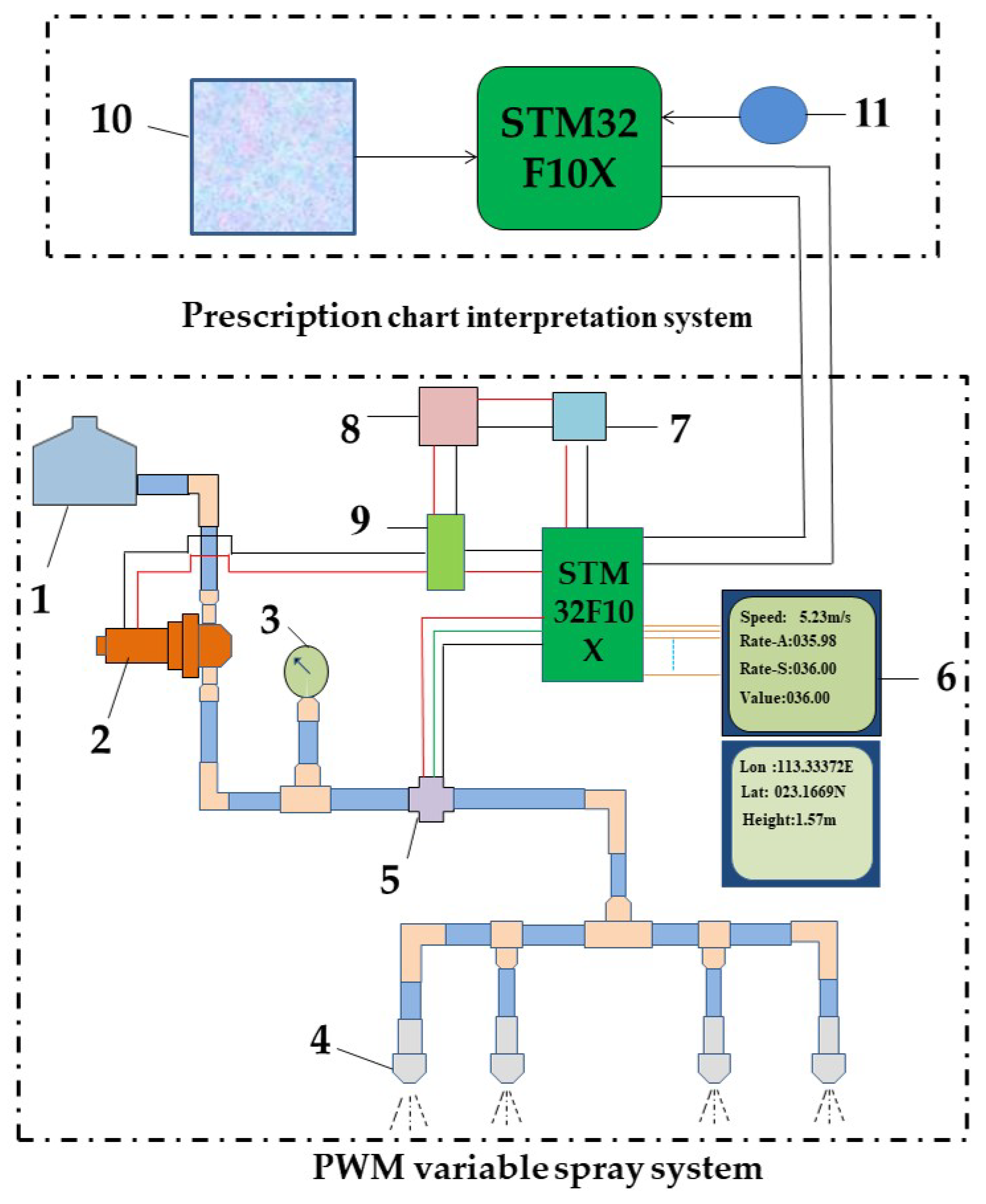
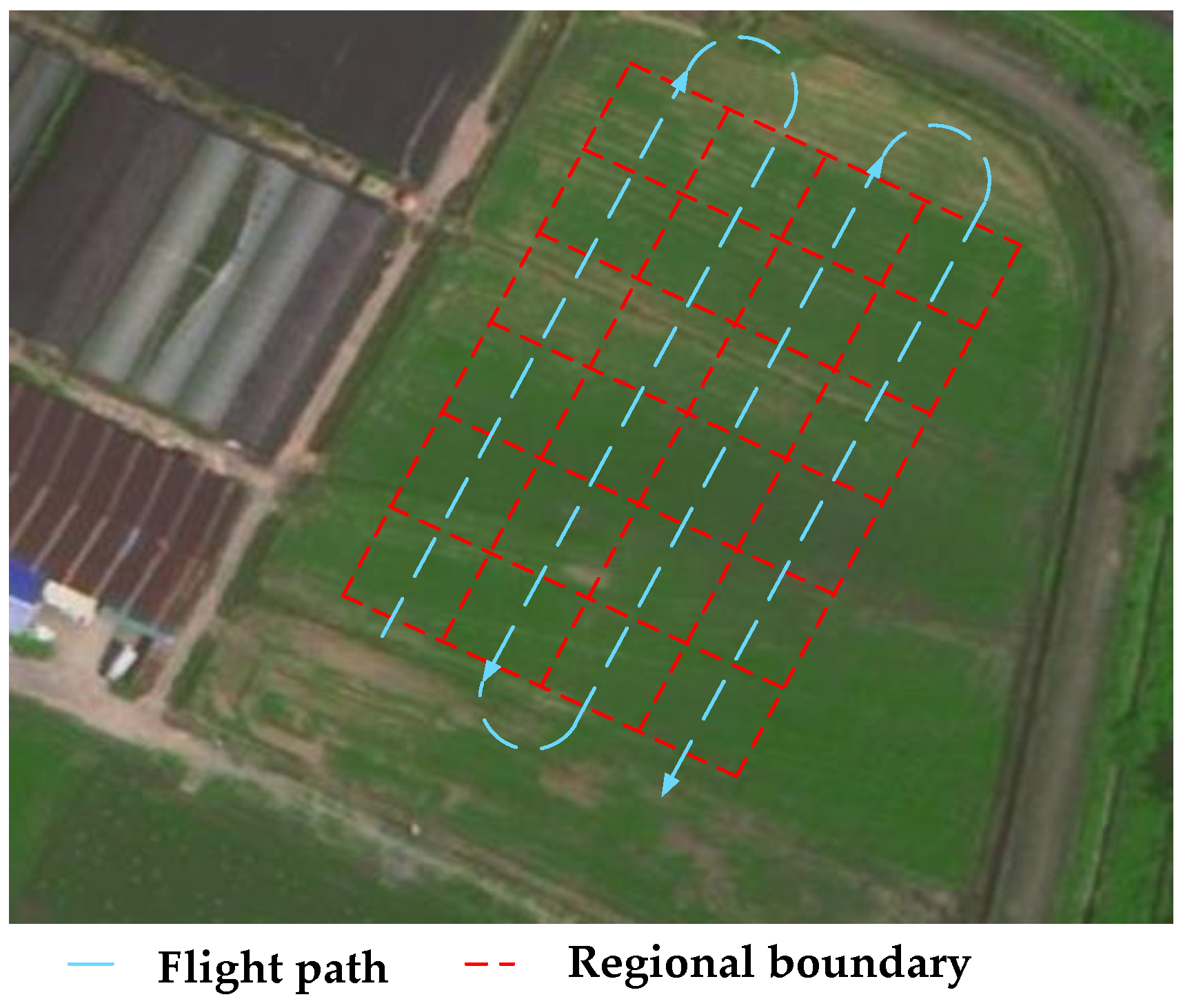
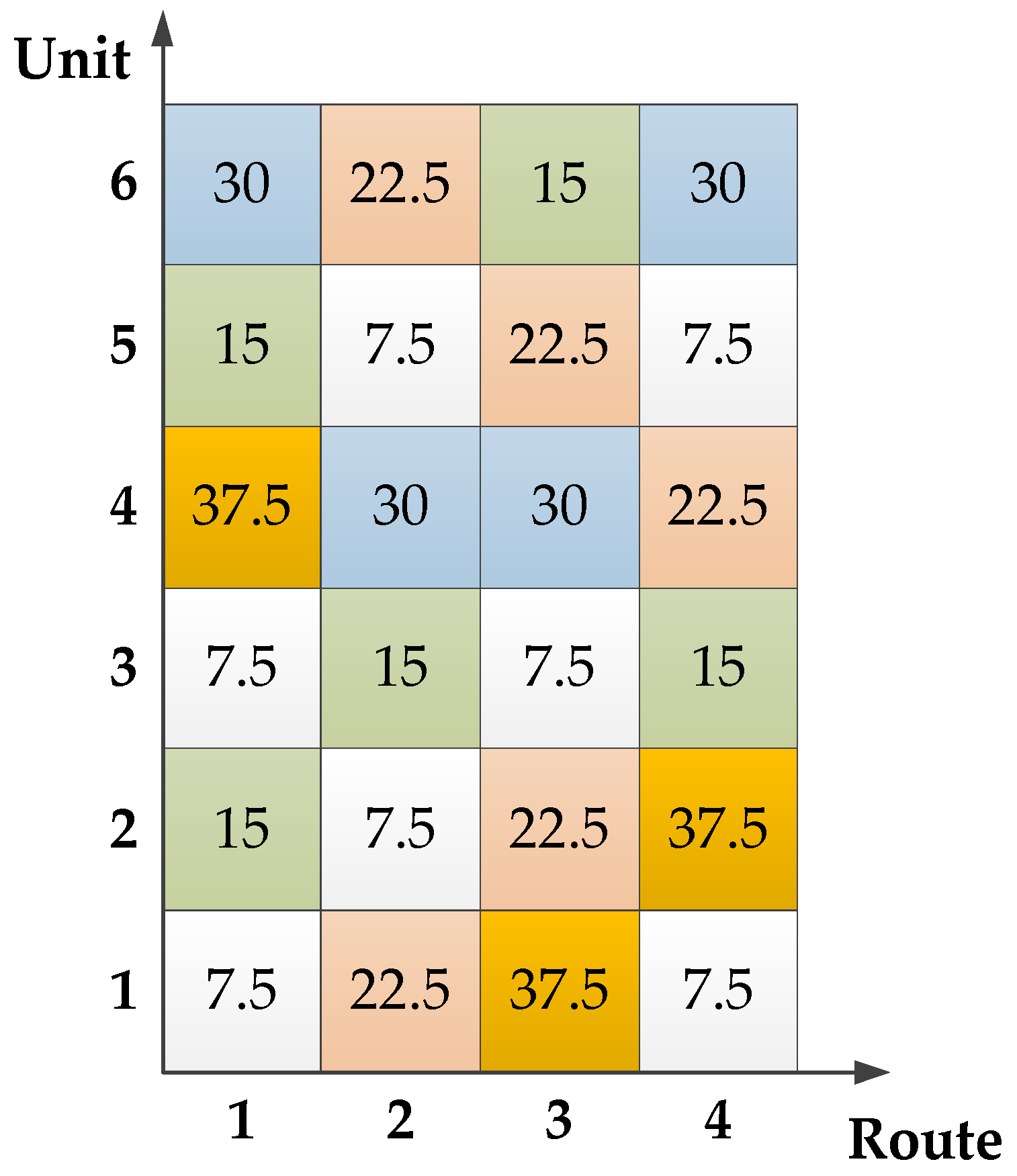
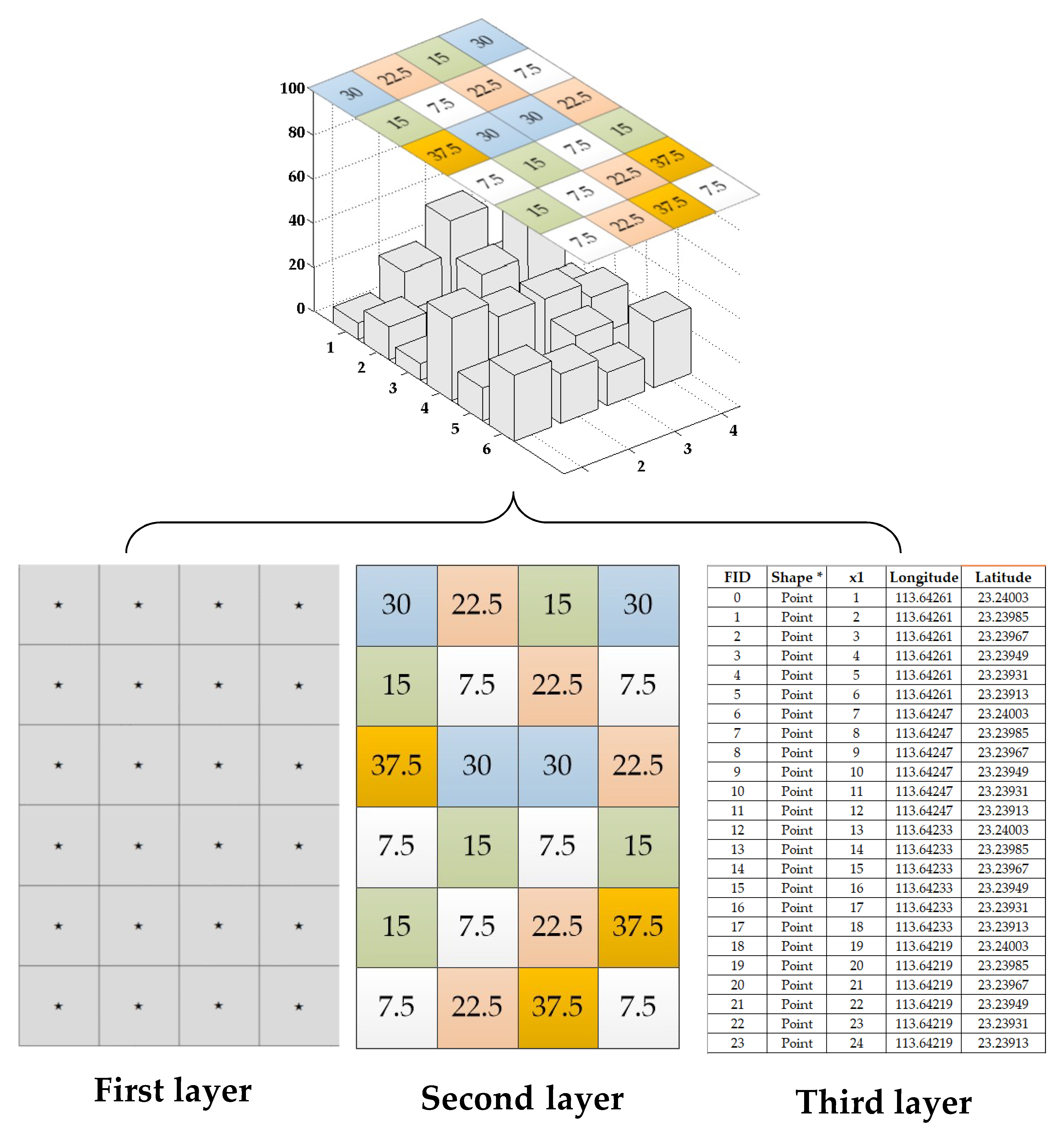
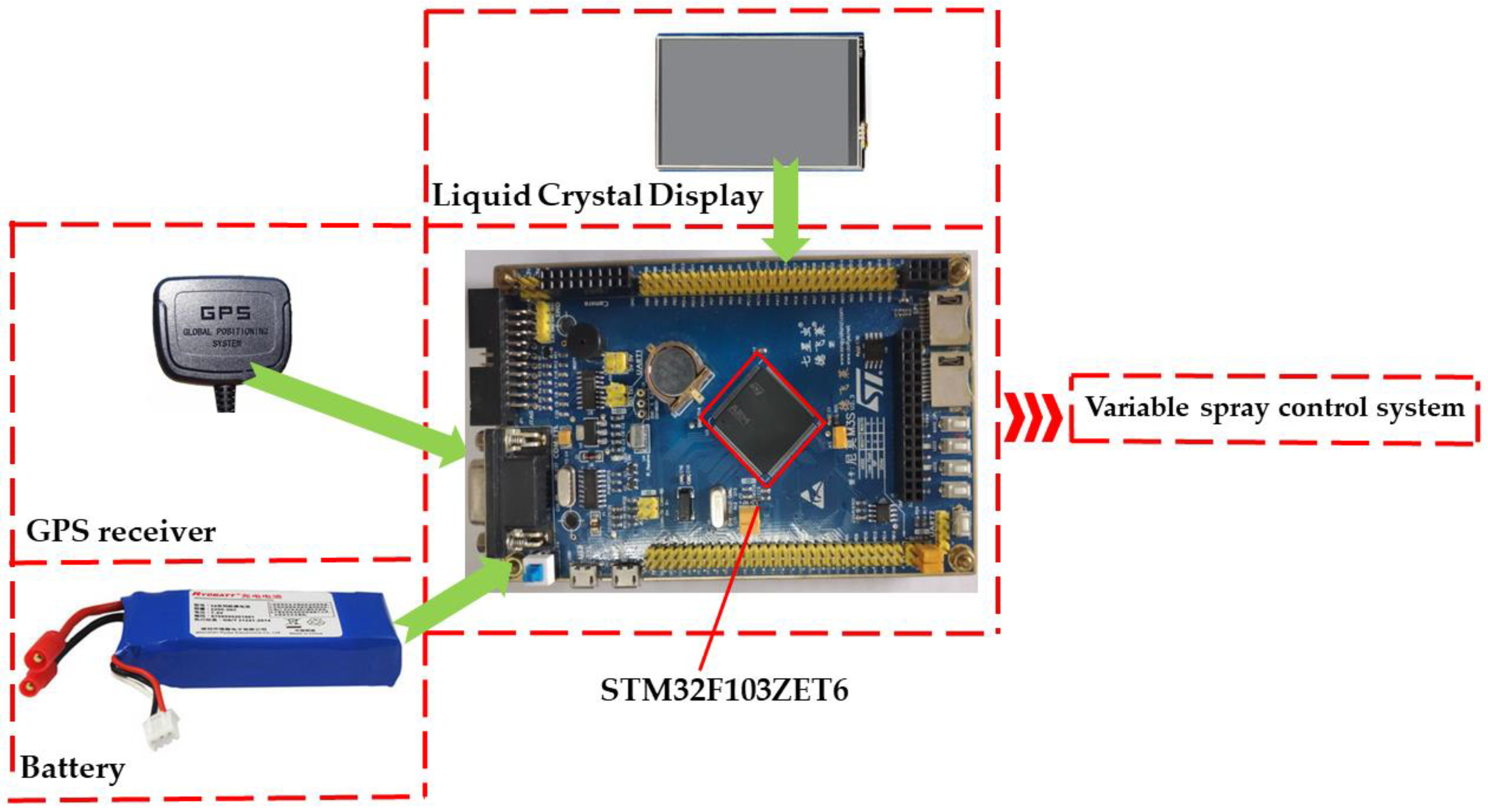
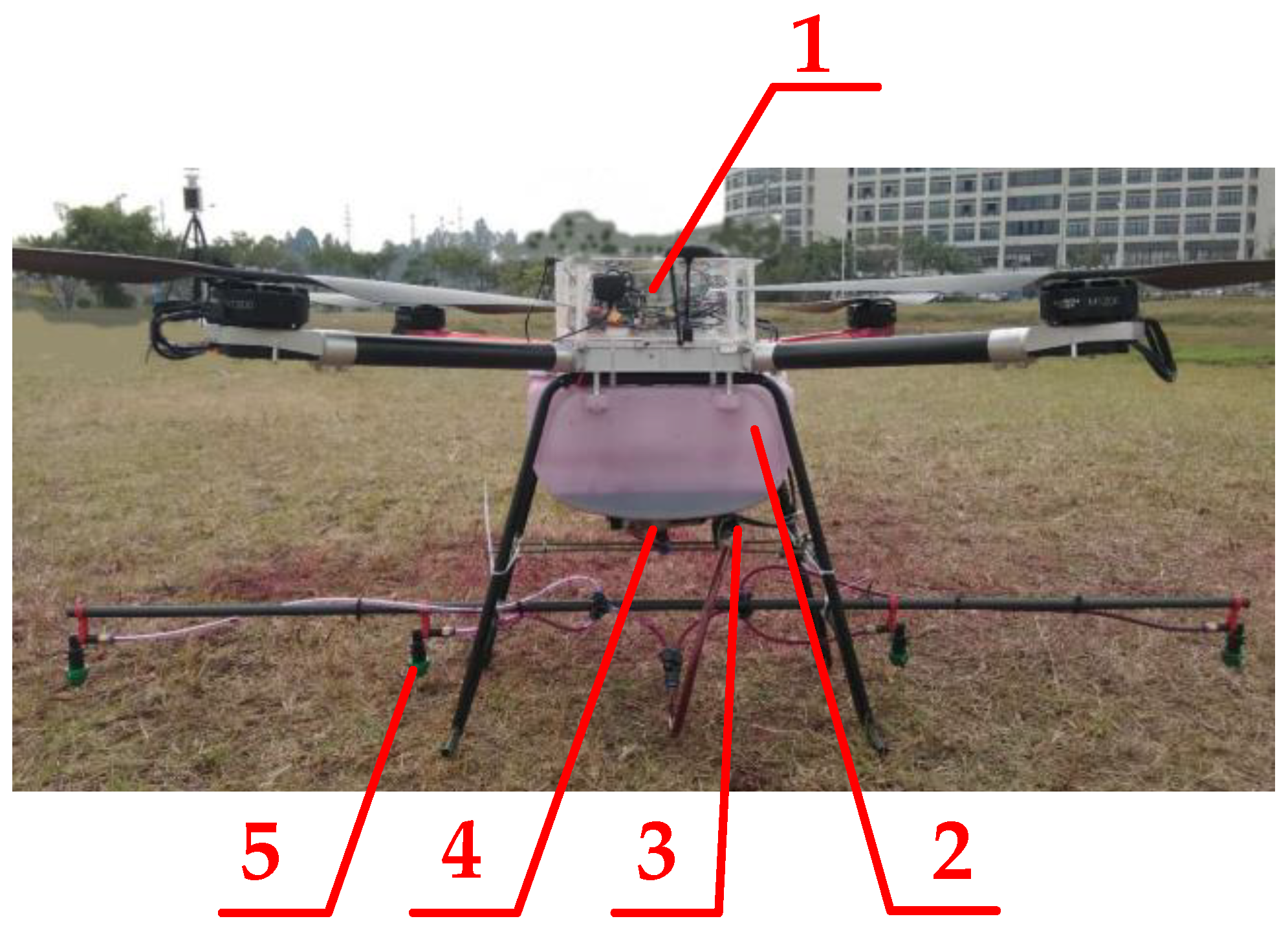
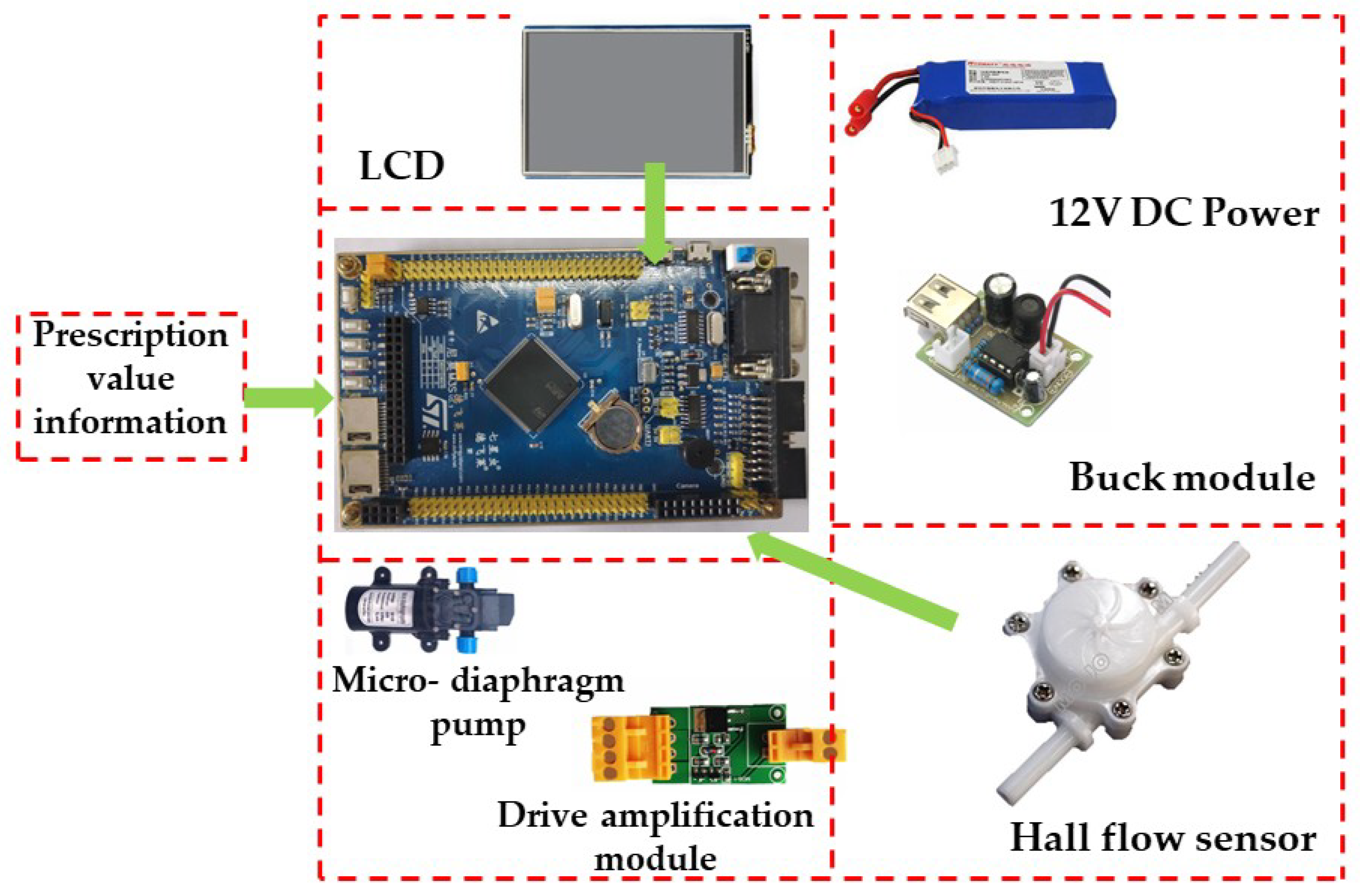
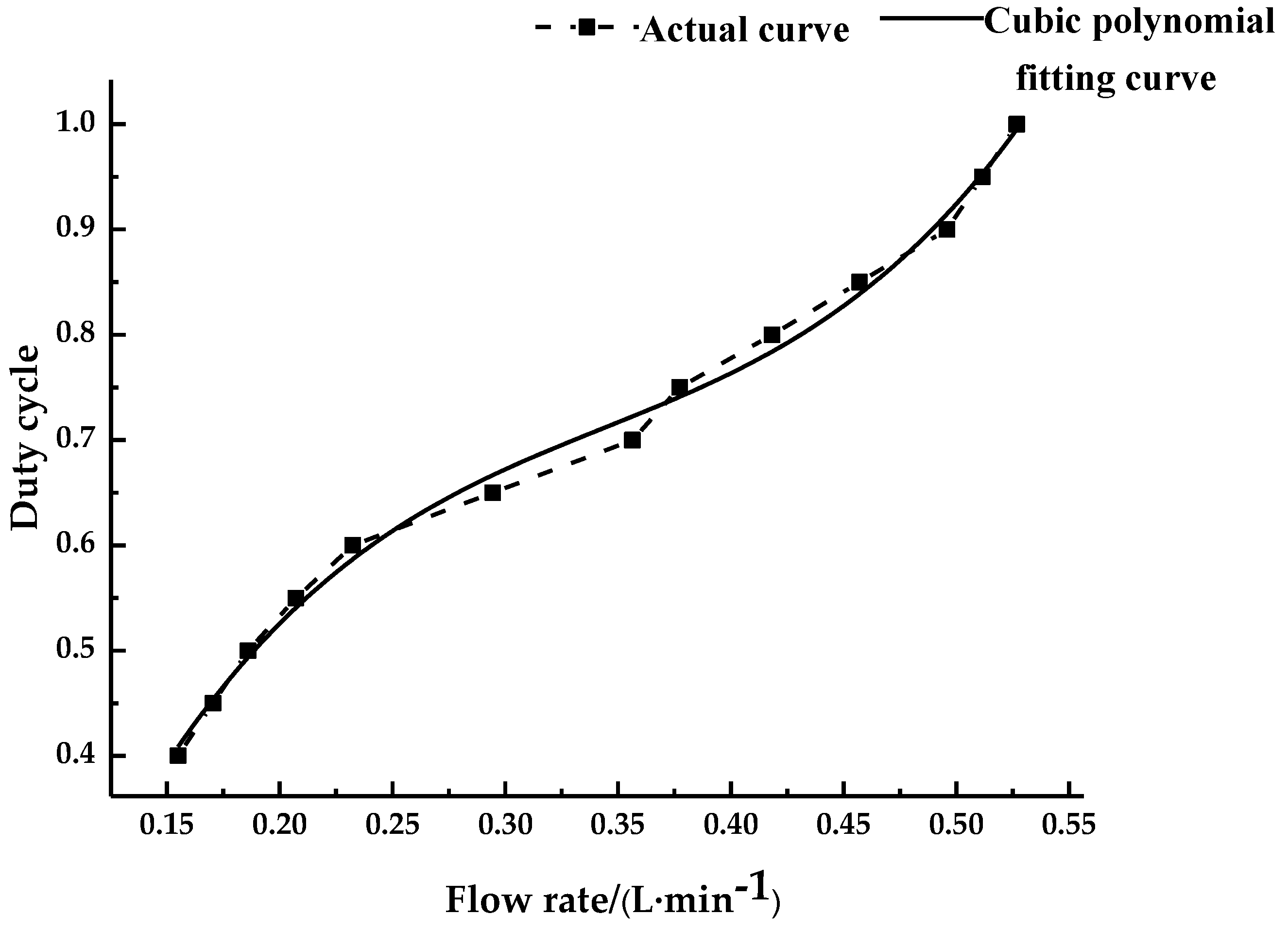


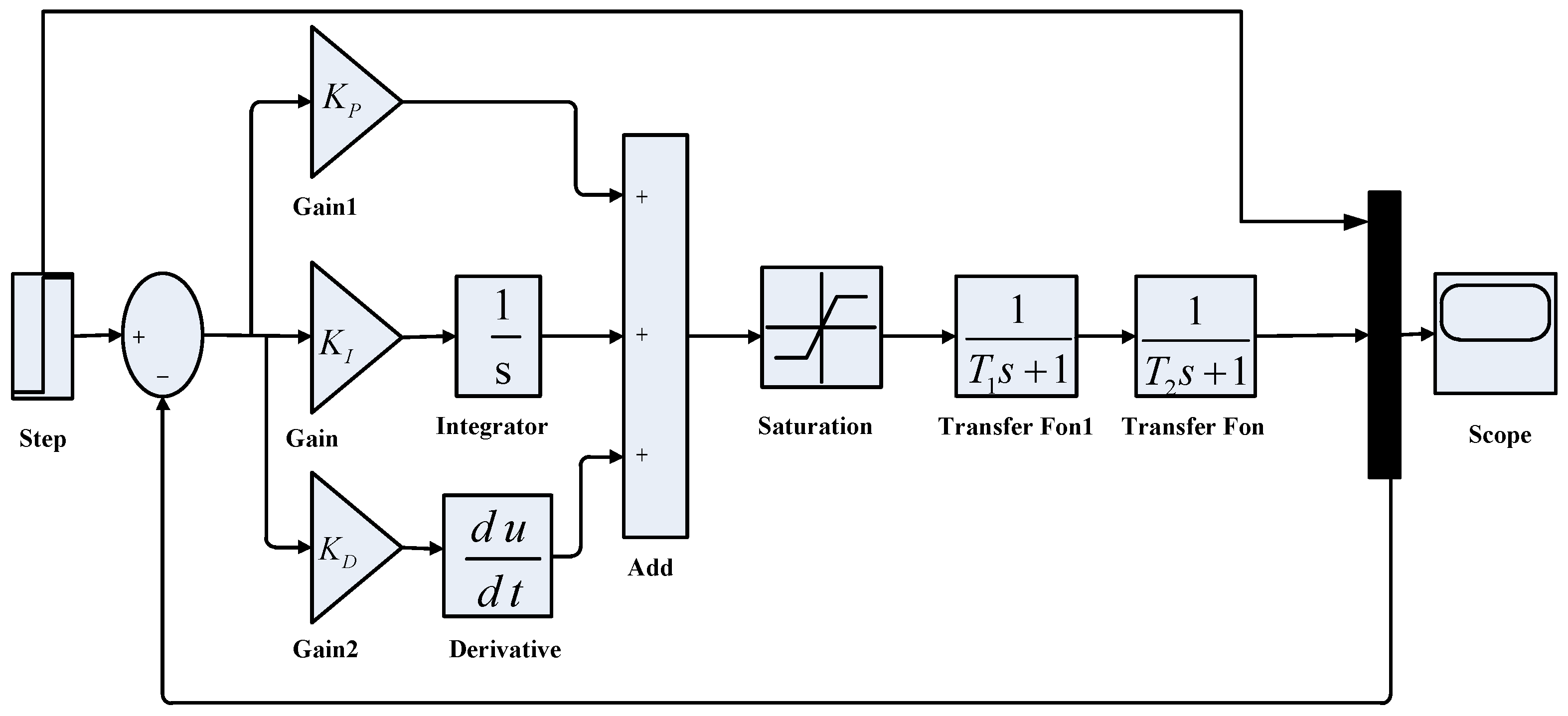
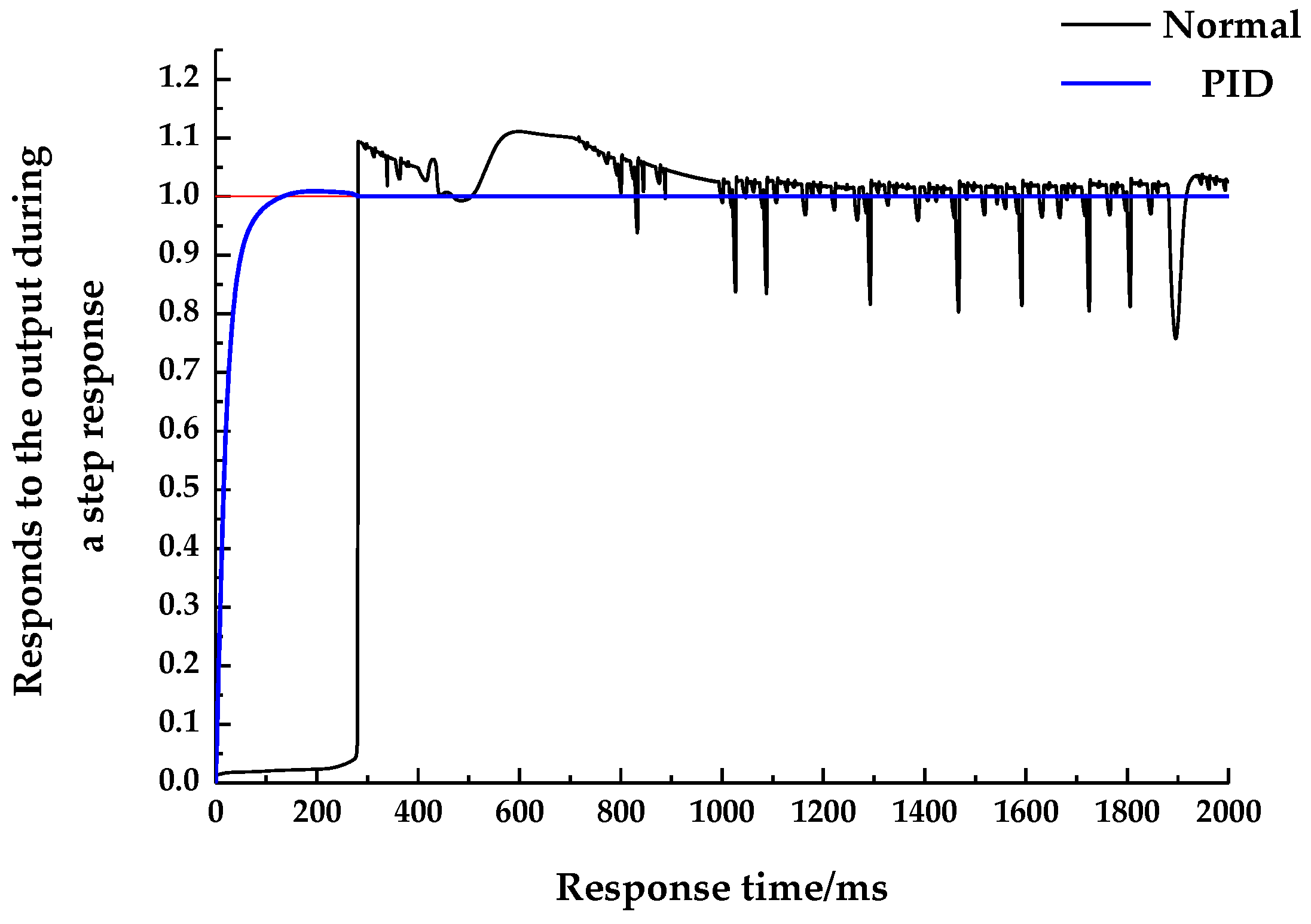
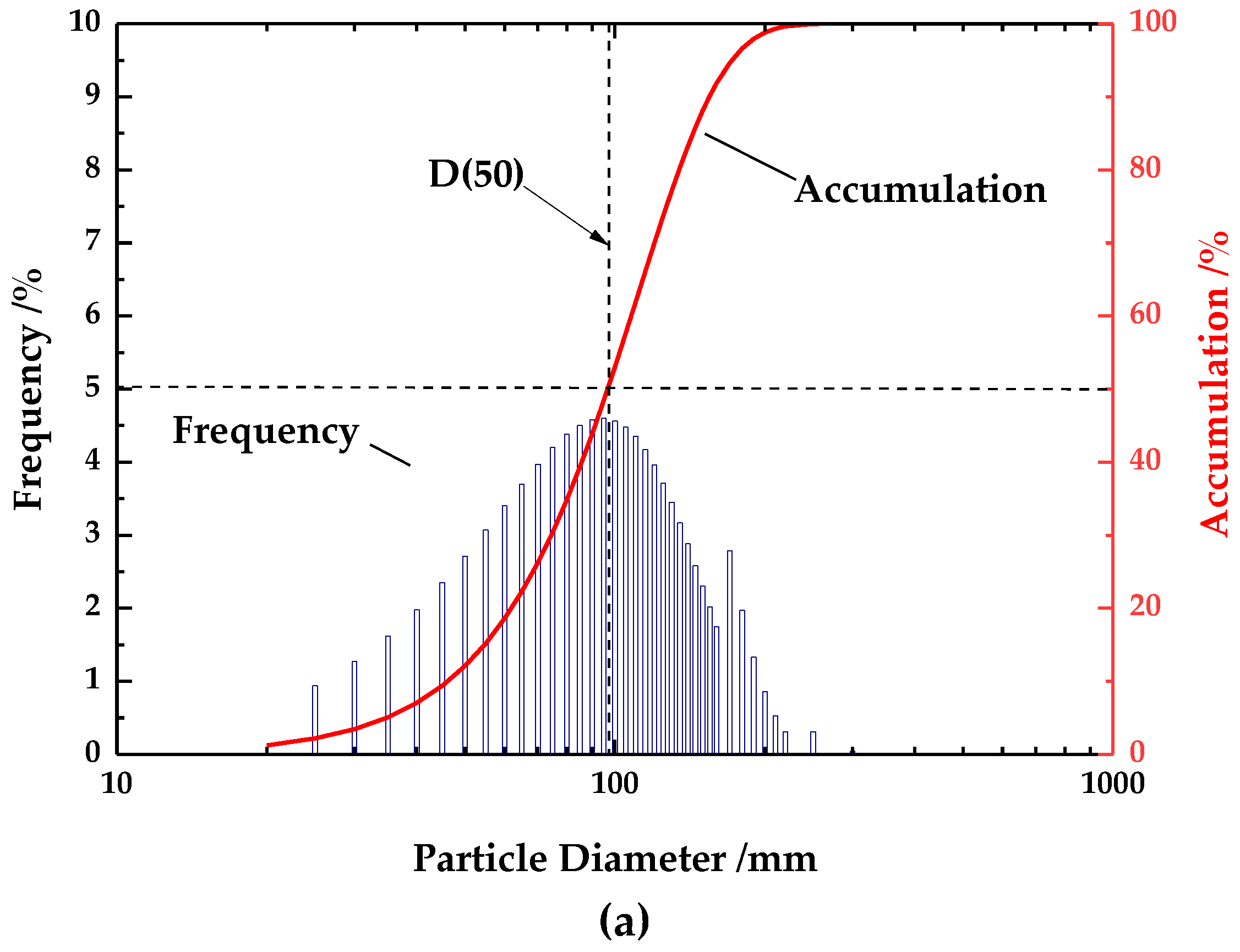
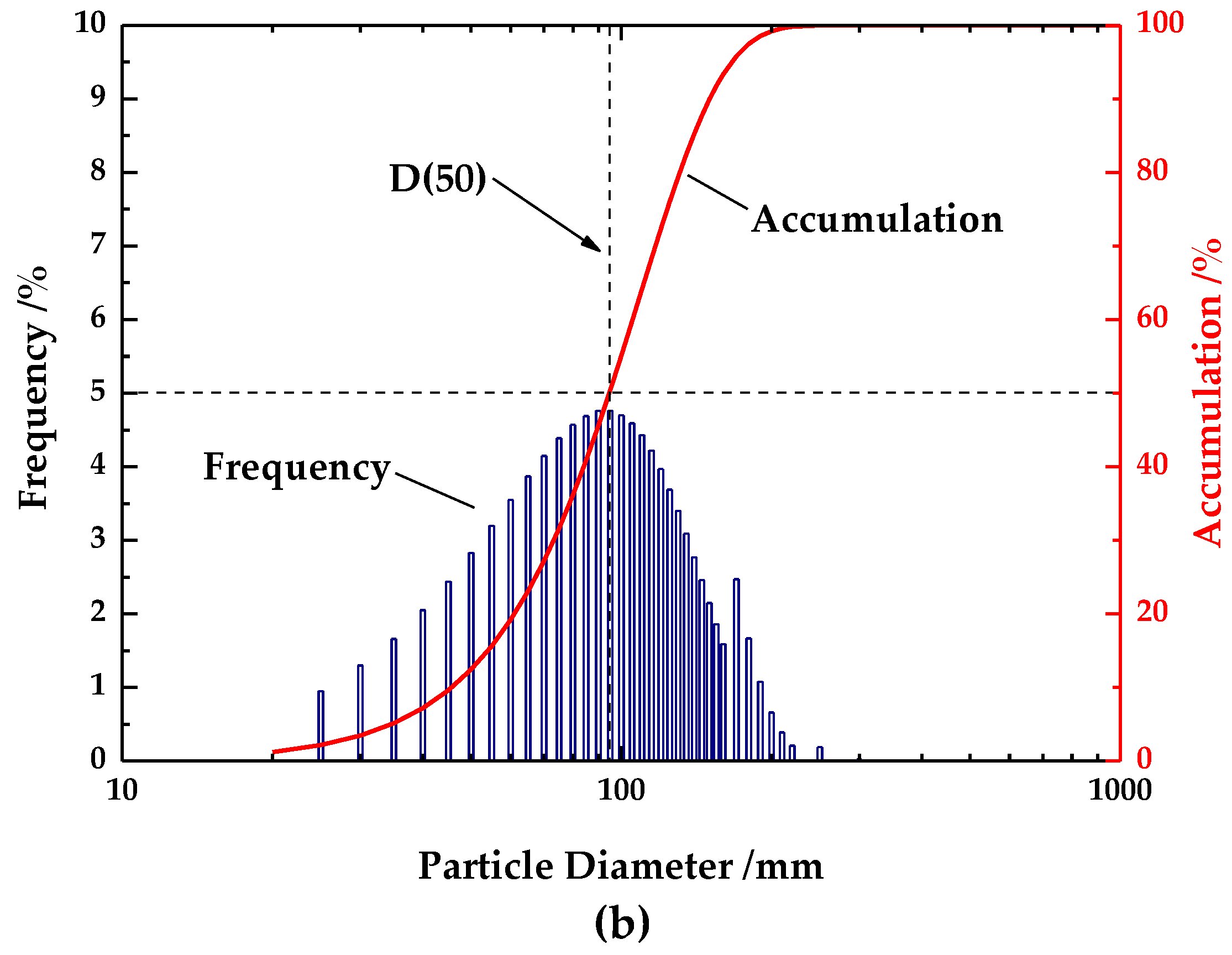
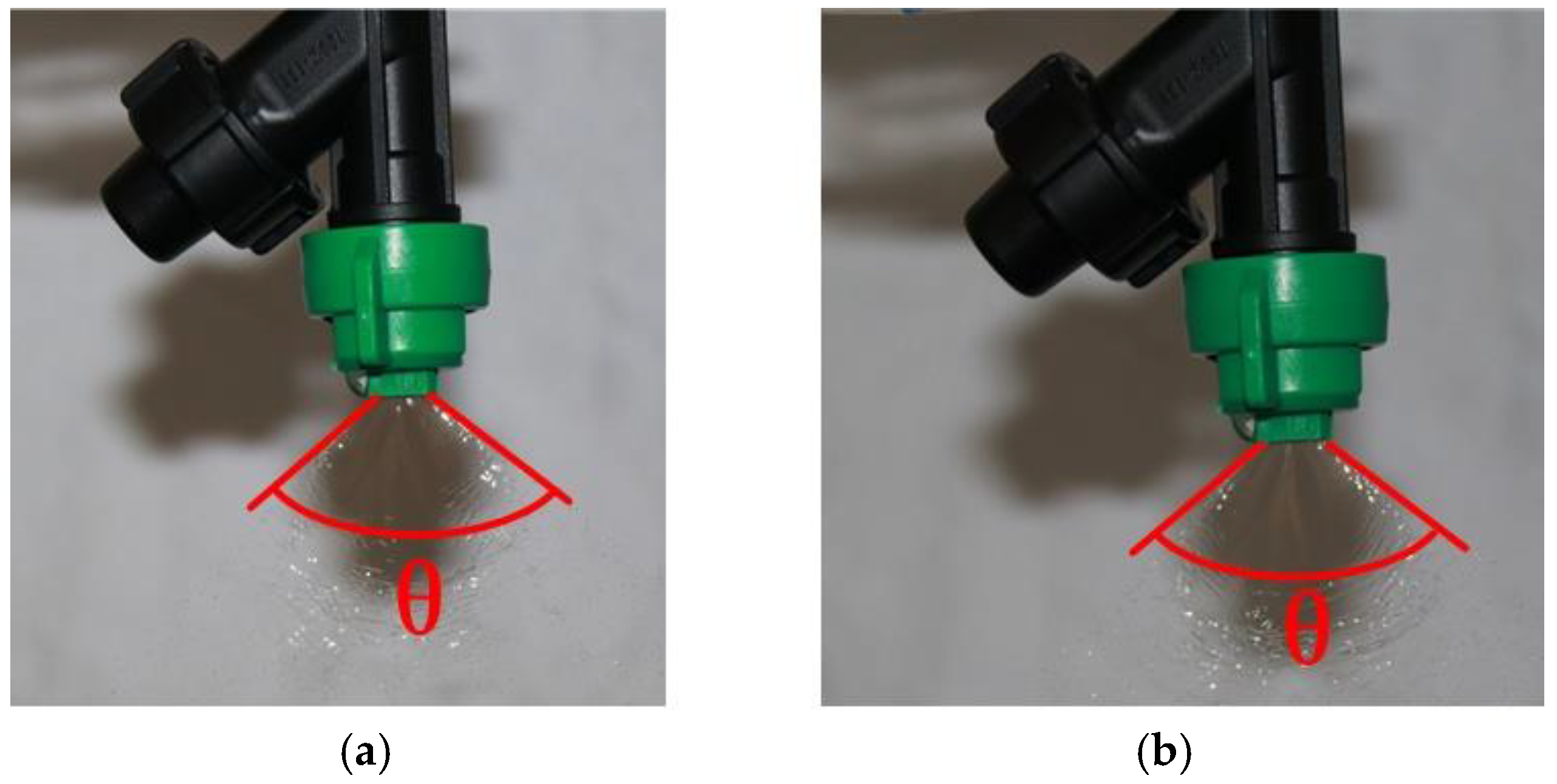
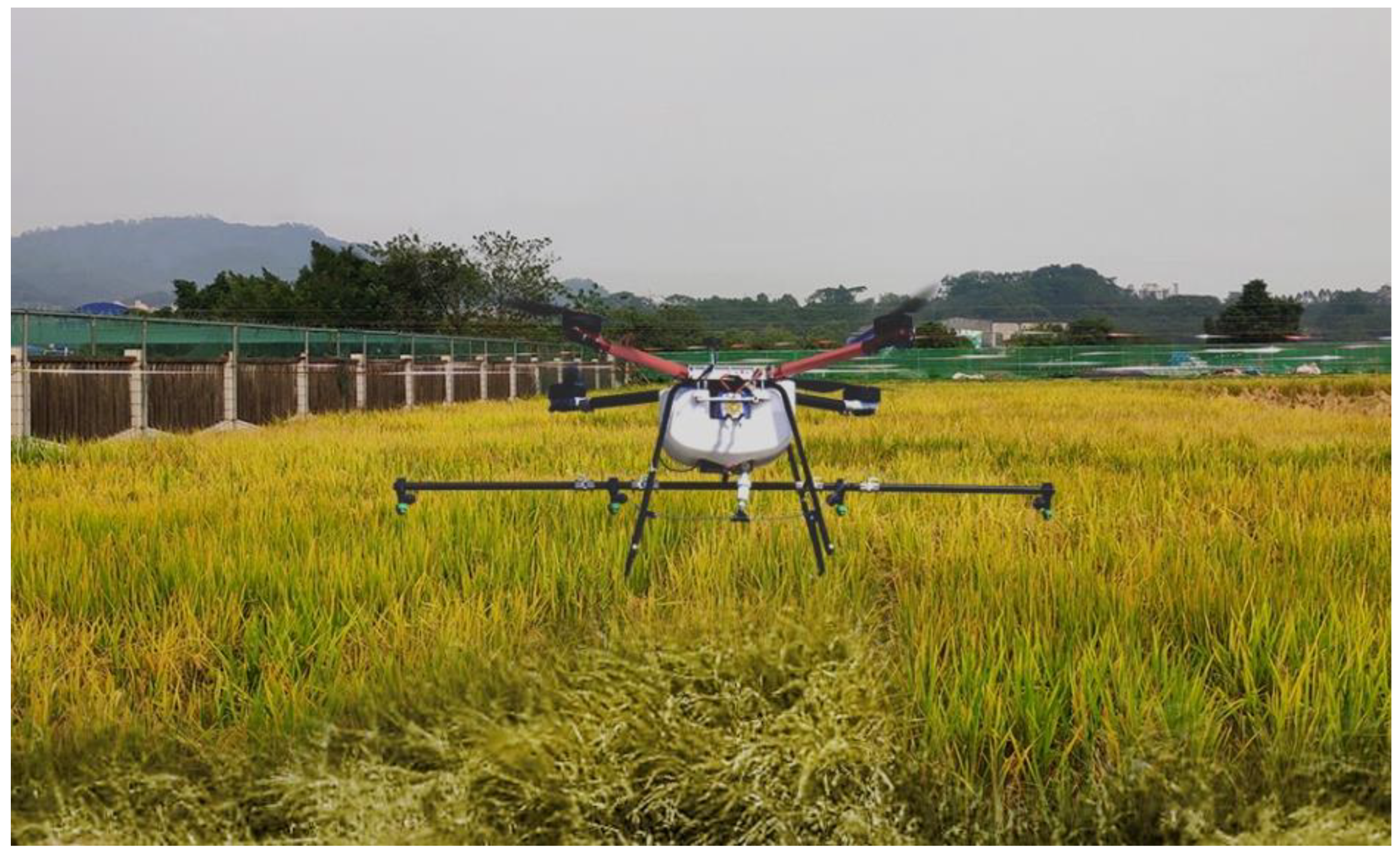
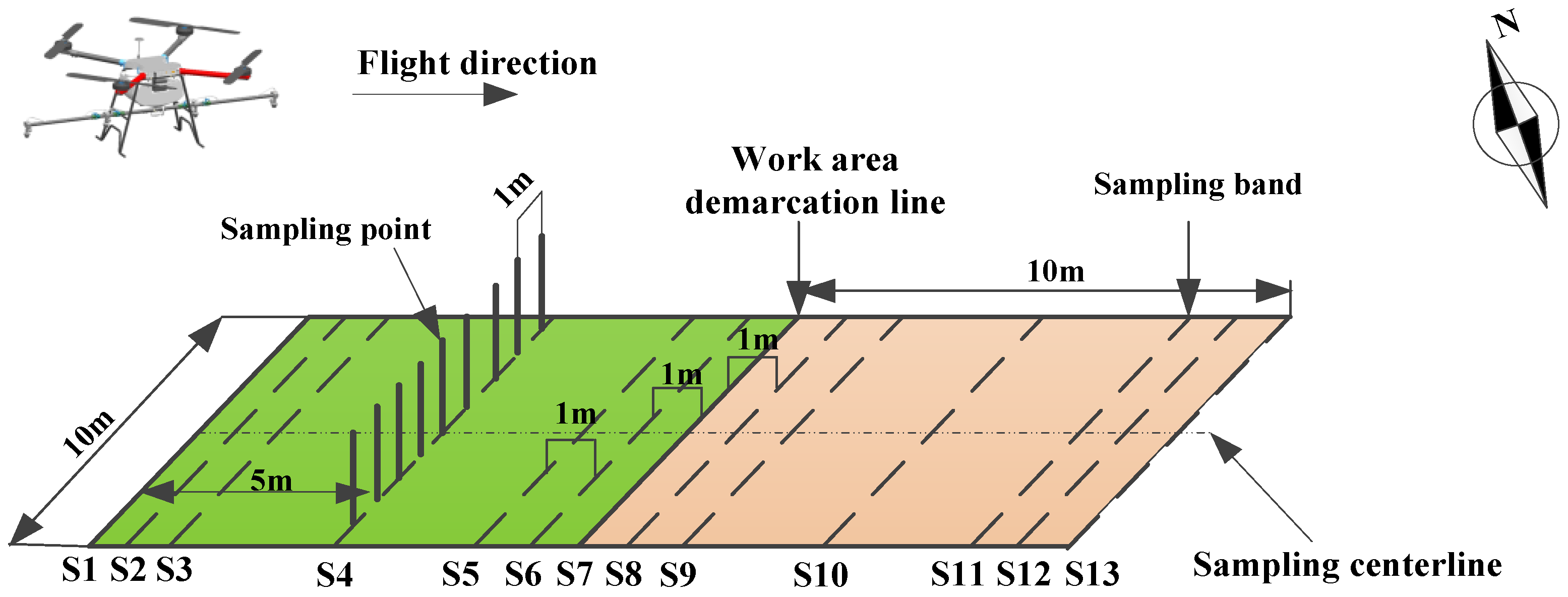
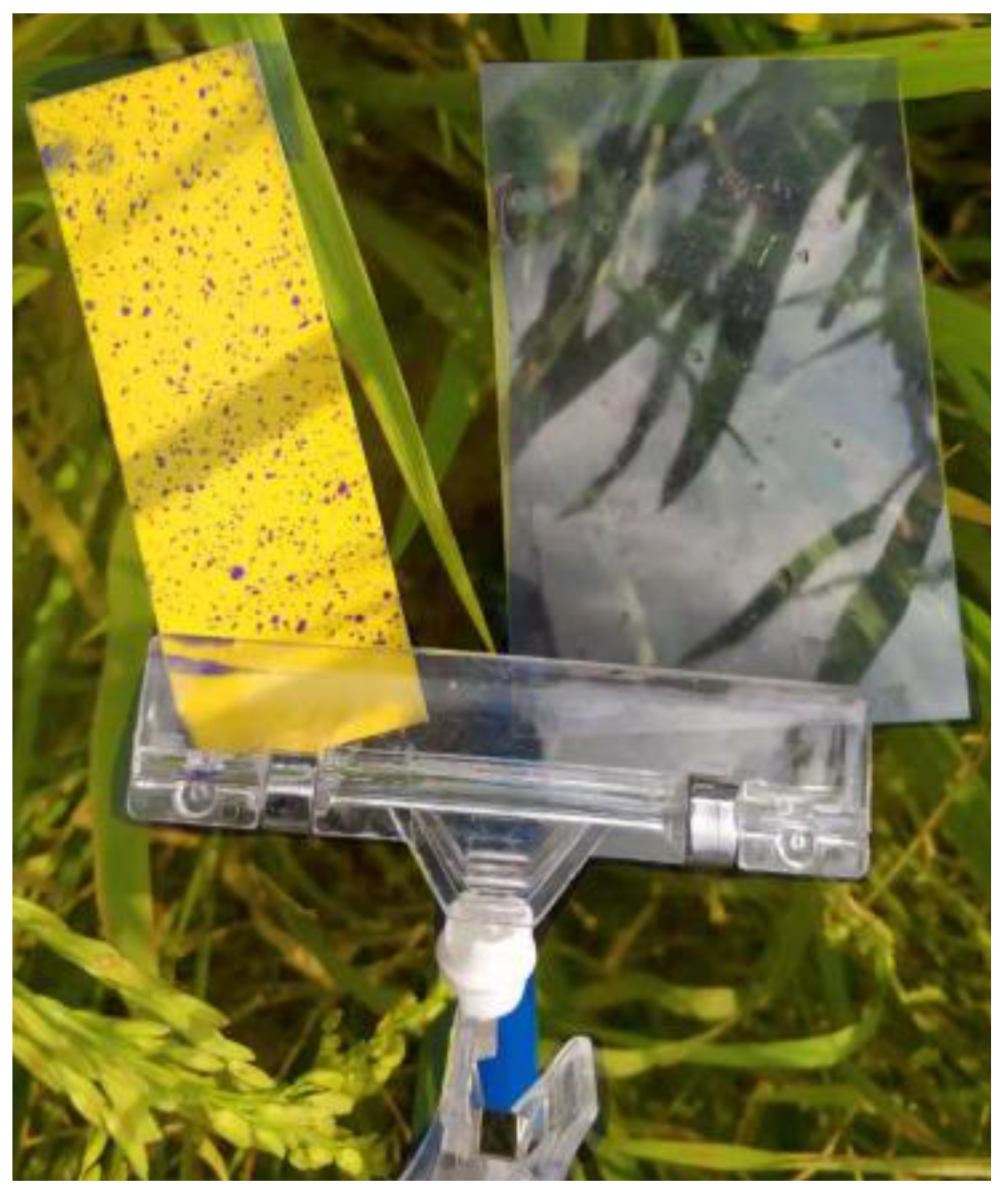
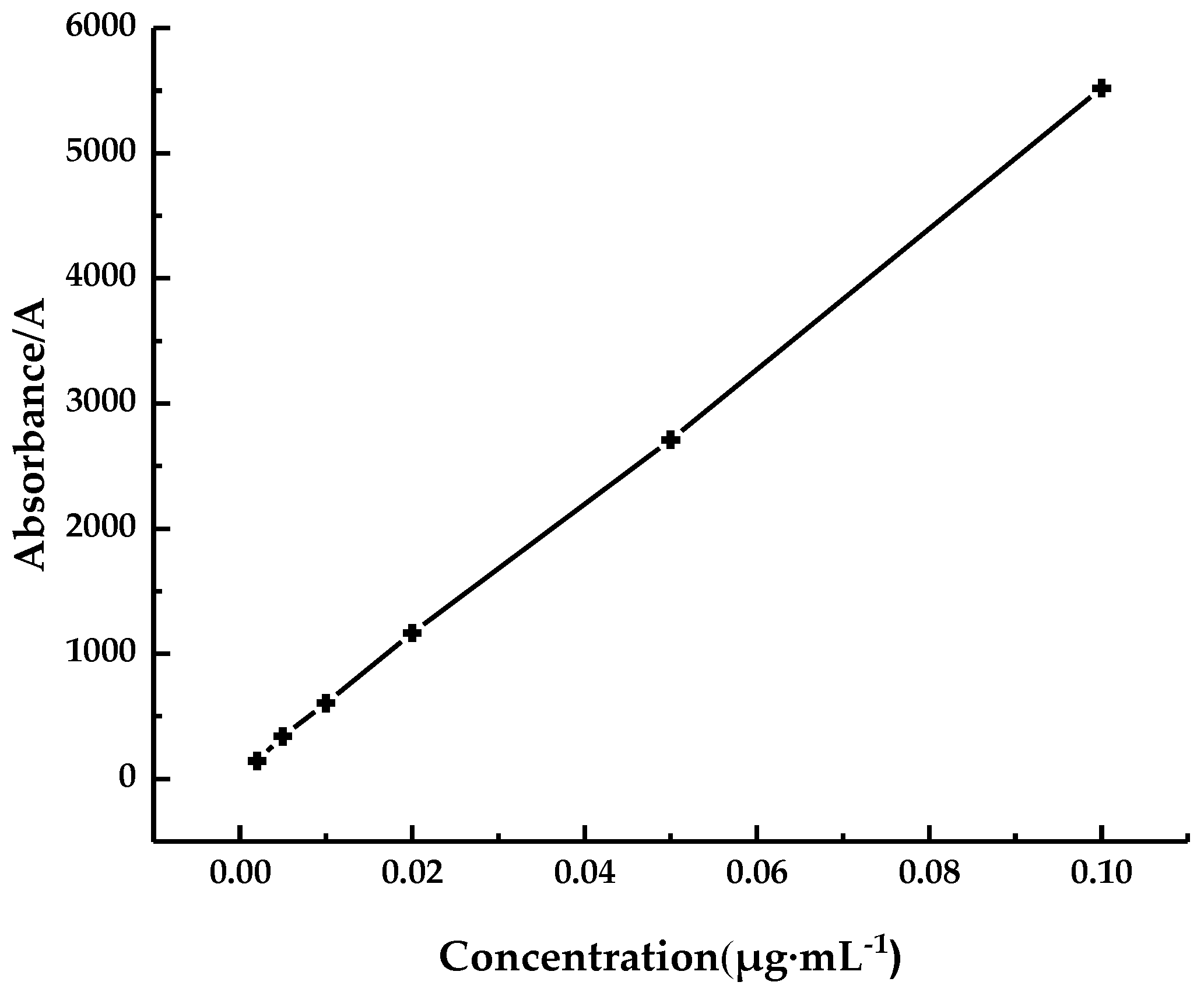
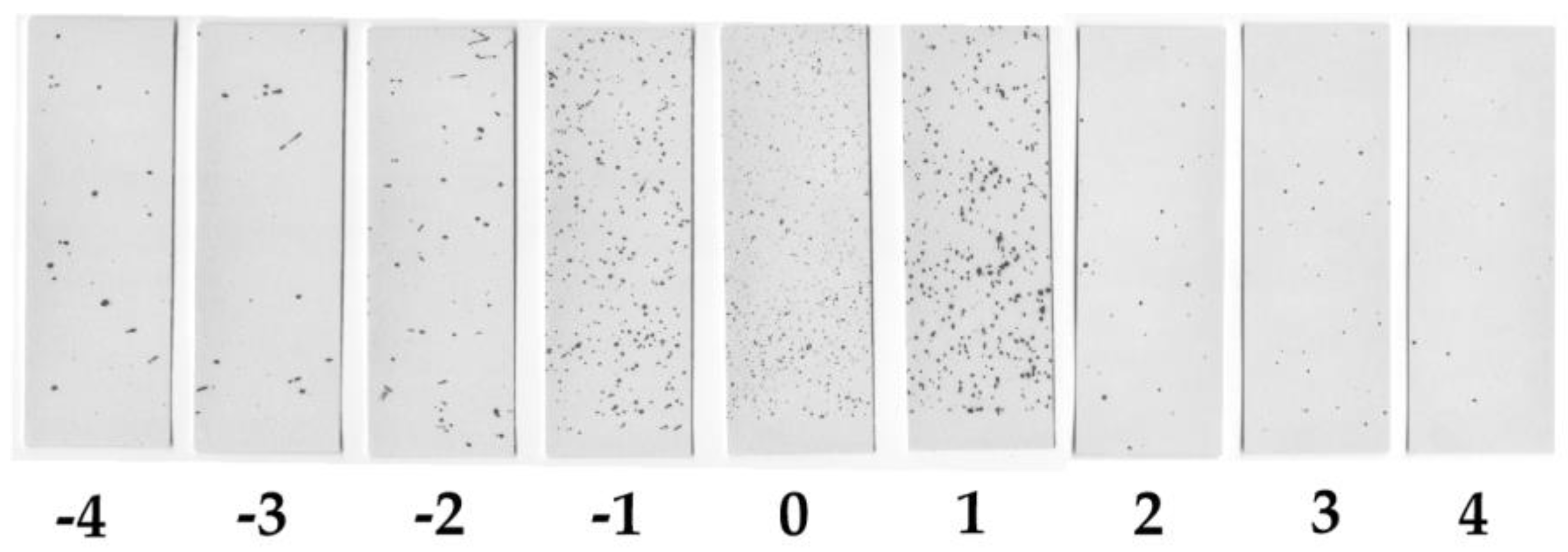
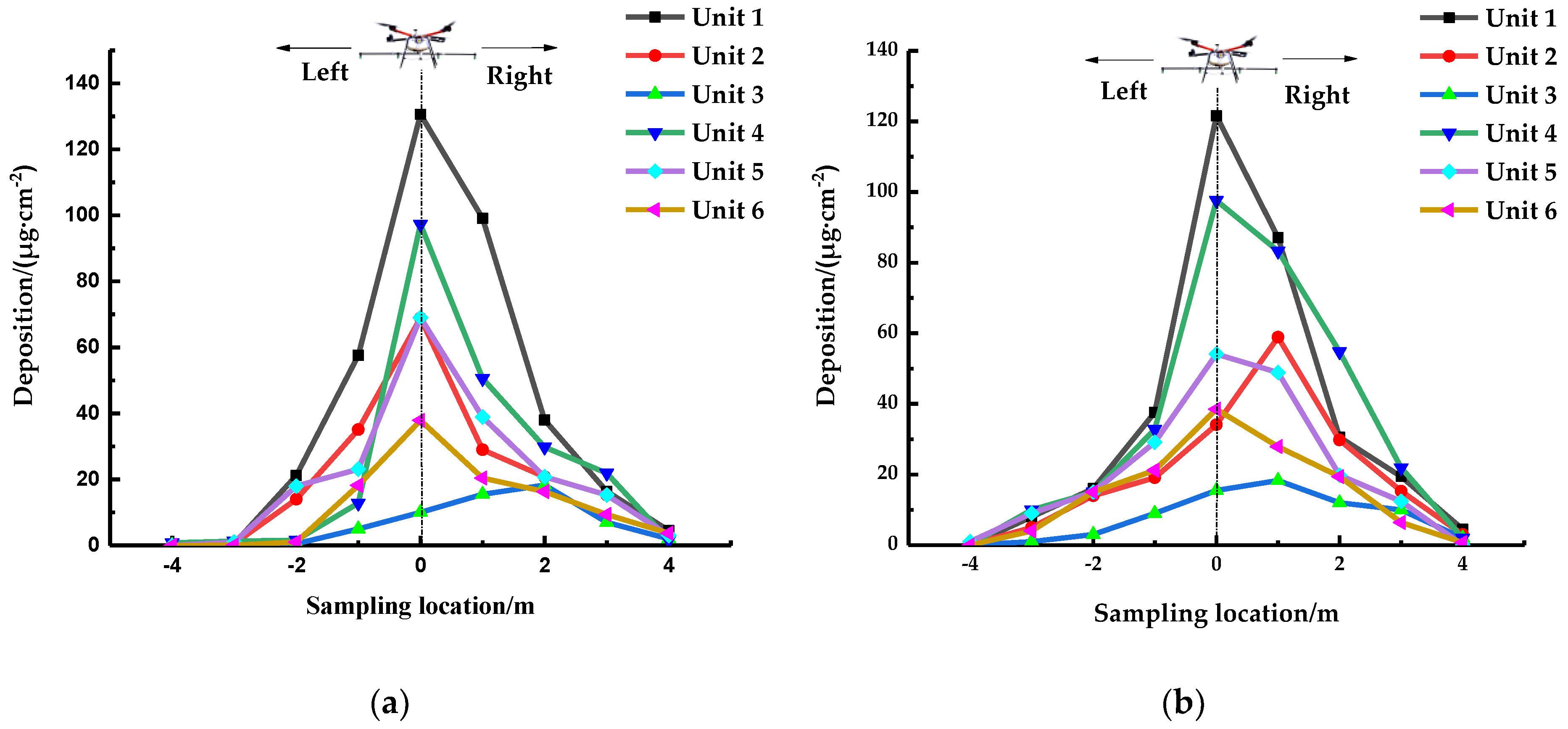
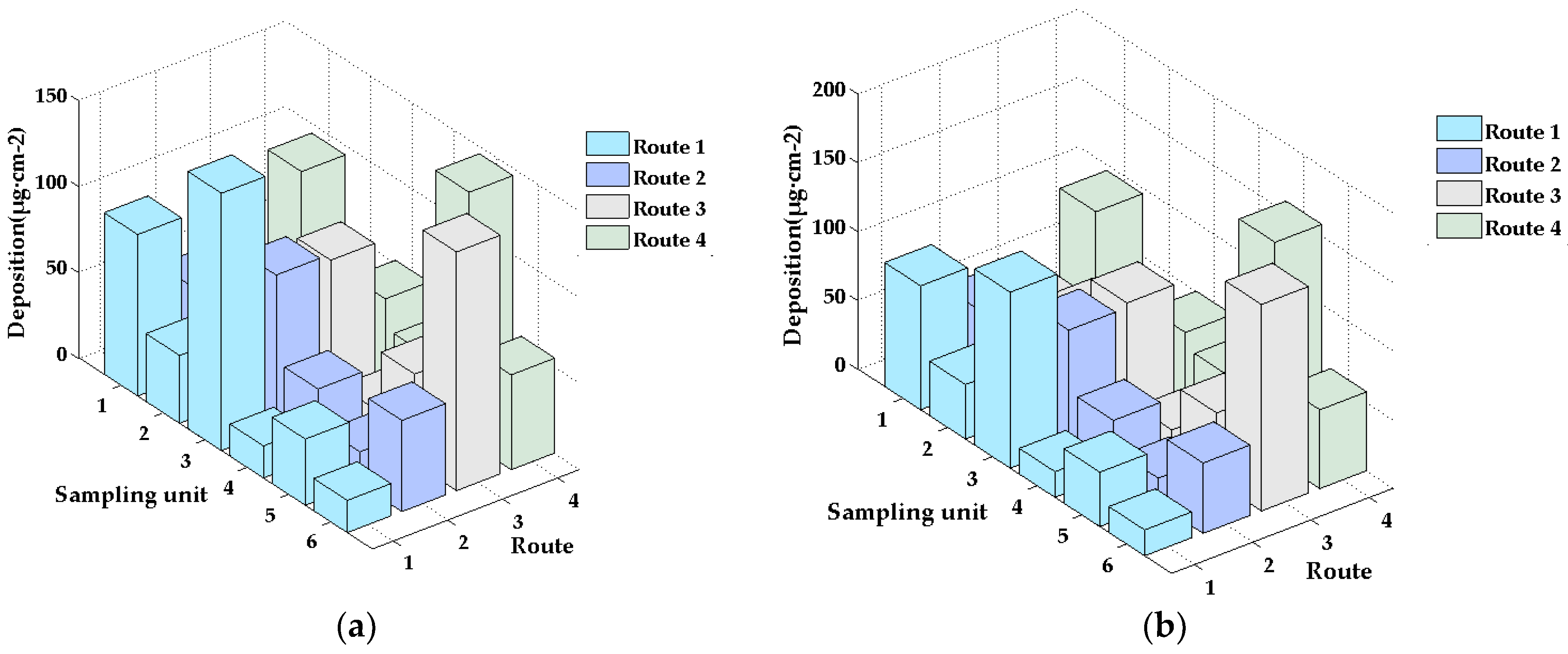

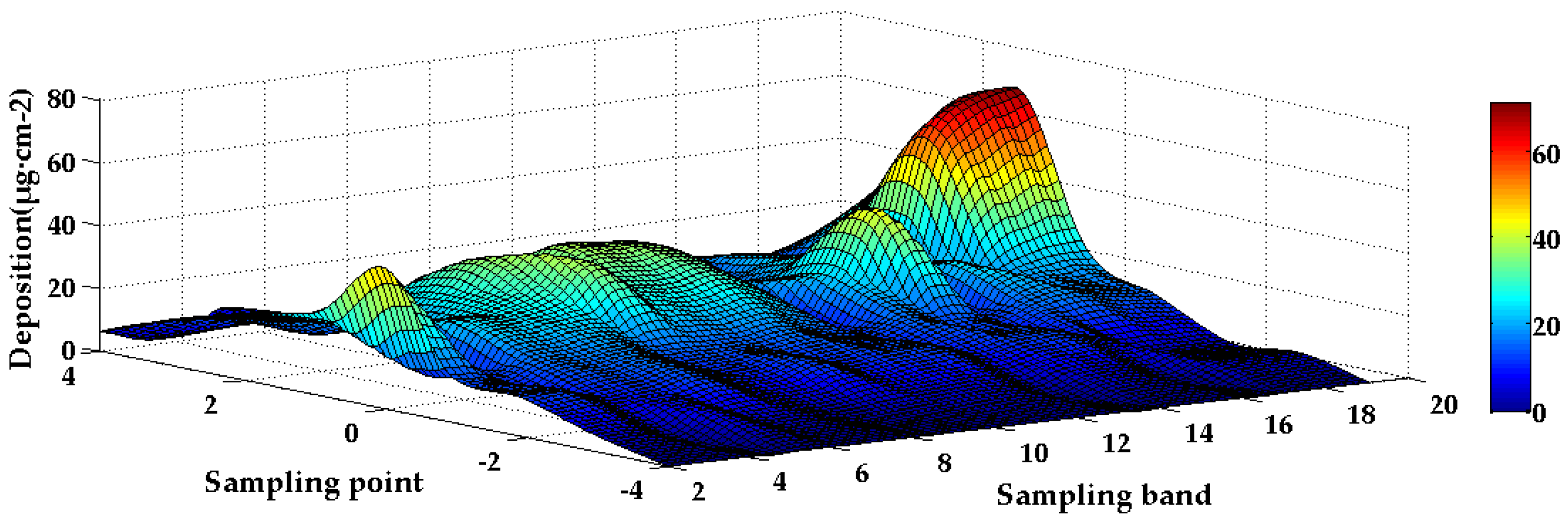
| Duty Cycle (%) | Volume Diameter (μm) | Spray Angle (°) |
|---|---|---|
| 40 | 99.81 | 98 |
| 45 | 98.72 | 99 |
| 50 | 97.85 | 97 |
| 55 | 97.46 | 99 |
| 60 | 97.32 | 98 |
| 65 | 97.07 | 99 |
| 70 | 96.73 | 100 |
| 75 | 96.77 | 98 |
| 80 | 96.49 | 101 |
| 85 | 96.26 | 102 |
| 90 | 95.79 | 104 |
| 95 | 95.65 | 105 |
| 100 | 94.59 | 105 |
| Duty Cycle (%) | Target Flow Rate (L·min−1) | Actual Flow Rate (L·min−1) | Deviation (%) |
|---|---|---|---|
| 40 | 0.1550 | 0.1508 | 2.71 |
| 45 | 0.1705 | 0.1682 | 1.35 |
| 50 | 0.1860 | 0.1805 | 1.34 |
| 55 | 0.2072 | 0.1950 | 5.89 |
| 60 | 0.2324 | 0.2290 | 1.46 |
| 65 | 0.2945 | 0.2894 | 1.73 |
| 70 | 0.3564 | 0.3487 | 2.16 |
| 75 | 0.3774 | 0.3683 | 2.41 |
| 80 | 0.4184 | 0.4097 | 2.08 |
| 85 | 0.4572 | 0.4493 | 1.73 |
| 90 | 0.4959 | 0.4850 | 2.20 |
| 95 | 0.5116 | 0.5064 | 1.02 |
| 100 | 0.5268 | 0.5159 | 2.07 |
| Sorties | Temperature (°C) | Humidity (%) | Wind Speed and Direction (m·s−1) |
|---|---|---|---|
| 1 | 19.5 | 54.3 | 0.54/SW |
| 2 | 20.1 | 54.2 | 0.78/SW |
| 3 | 21.3 | 53.9 | 0.84/SW |
| 4 | 22.6 | 53.7 | 0.47/SW |
| Sortie | Unit | Sampling Point | Average | Coefficient of Variation | ||||||||
|---|---|---|---|---|---|---|---|---|---|---|---|---|
| −4 | −3 | −2 | −1 | 0 | 1 | 2 | 3 | 4 | ||||
| First | 1 | 6 | 16 | 19 | 29 | 44 | 31 | 23 | 14 | 9 | 25.14 | 38.07% 32.5% 237.77% |
| 2 | 2 | 17 | 22 | 37 | 81 | 54 | 22 | 10 | 8 | 34.71 | ||
| 3 | 0 | 15 | 19 | 26 | 47 | 34 | 17 | 6 | 0 | 23.43 | ||
| 4 | 13 | 26 | 57 | 123 | 169 | 115 | 41 | 23 | 12 | 79.14 | ||
| 5 | 1 | 9 | 16 | 39 | 73 | 27 | 18 | 7 | 0 | 27 | 56.88% 72.48% | |
| 6 | 0 | 14 | 23 | 45 | 137 | 67 | 24 | 16 | 3 | 46.57 | ||
| Second | 1 | 0 | 12 | 19 | 24 | 41 | 31 | 20 | 16 | 4 | 23.29 | 59.47% 28.08% 73.83% |
| 2 | 9 | 16 | 22 | 37 | 93 | 49 | 29 | 14 | 0 | 37.14 | ||
| 3 | 0 | 15 | 23 | 36 | 55 | 29 | 16 | 13 | 1 | 26.71 | ||
| 4 | 4 | 21 | 33 | 59 | 143 | 37 | 20 | 12 | 0 | 46.43 | 47.9% 113.54% | |
| 5 | 1 | 6 | 15 | 23 | 69 | 31 | 18 | 7 | 0 | 24.15 | ||
| 6 | 3 | 14 | 29 | 67 | 115 | 89 | 32 | 15 | 3 | 51.57 | ||
| Unit | Prescription Value (L·hm−2) | Sampling Band | Deposition (μg·cm−2) |
|---|---|---|---|
| 1 | 7.5 | S2 | 22.58 |
| S3 | 21.89 | ||
| Boundary | S4 | 20.63 | |
| 2 | 15 | S5 | 35.68 |
| S6 | 39.43 | ||
| S7 | 39.21 | ||
| S8 | 40.28 | ||
| S9 | 38.64 | ||
| Boundary | S10 | 39.46 | |
| 3 | 7.5 | S11 | 27.64 |
| S12 | 23.64 | ||
| S13 | 24.06 | ||
| S14 | 21.96 | ||
| S15 | 22.68 | ||
| Boundary | S16 | 23.07 | |
| 4 | 37.5 | S17 | 69.76 |
| S18 | 129.87 | ||
| S19 | 134.26 |
© 2018 by the authors. Licensee MDPI, Basel, Switzerland. This article is an open access article distributed under the terms and conditions of the Creative Commons Attribution (CC BY) license (http://creativecommons.org/licenses/by/4.0/).
Share and Cite
Wen, S.; Zhang, Q.; Deng, J.; Lan, Y.; Yin, X.; Shan, J. Design and Experiment of a Variable Spray System for Unmanned Aerial Vehicles Based on PID and PWM Control. Appl. Sci. 2018, 8, 2482. https://doi.org/10.3390/app8122482
Wen S, Zhang Q, Deng J, Lan Y, Yin X, Shan J. Design and Experiment of a Variable Spray System for Unmanned Aerial Vehicles Based on PID and PWM Control. Applied Sciences. 2018; 8(12):2482. https://doi.org/10.3390/app8122482
Chicago/Turabian StyleWen, Sheng, Quanyong Zhang, Jizhong Deng, Yubin Lan, Xuanchun Yin, and Jian Shan. 2018. "Design and Experiment of a Variable Spray System for Unmanned Aerial Vehicles Based on PID and PWM Control" Applied Sciences 8, no. 12: 2482. https://doi.org/10.3390/app8122482
APA StyleWen, S., Zhang, Q., Deng, J., Lan, Y., Yin, X., & Shan, J. (2018). Design and Experiment of a Variable Spray System for Unmanned Aerial Vehicles Based on PID and PWM Control. Applied Sciences, 8(12), 2482. https://doi.org/10.3390/app8122482





